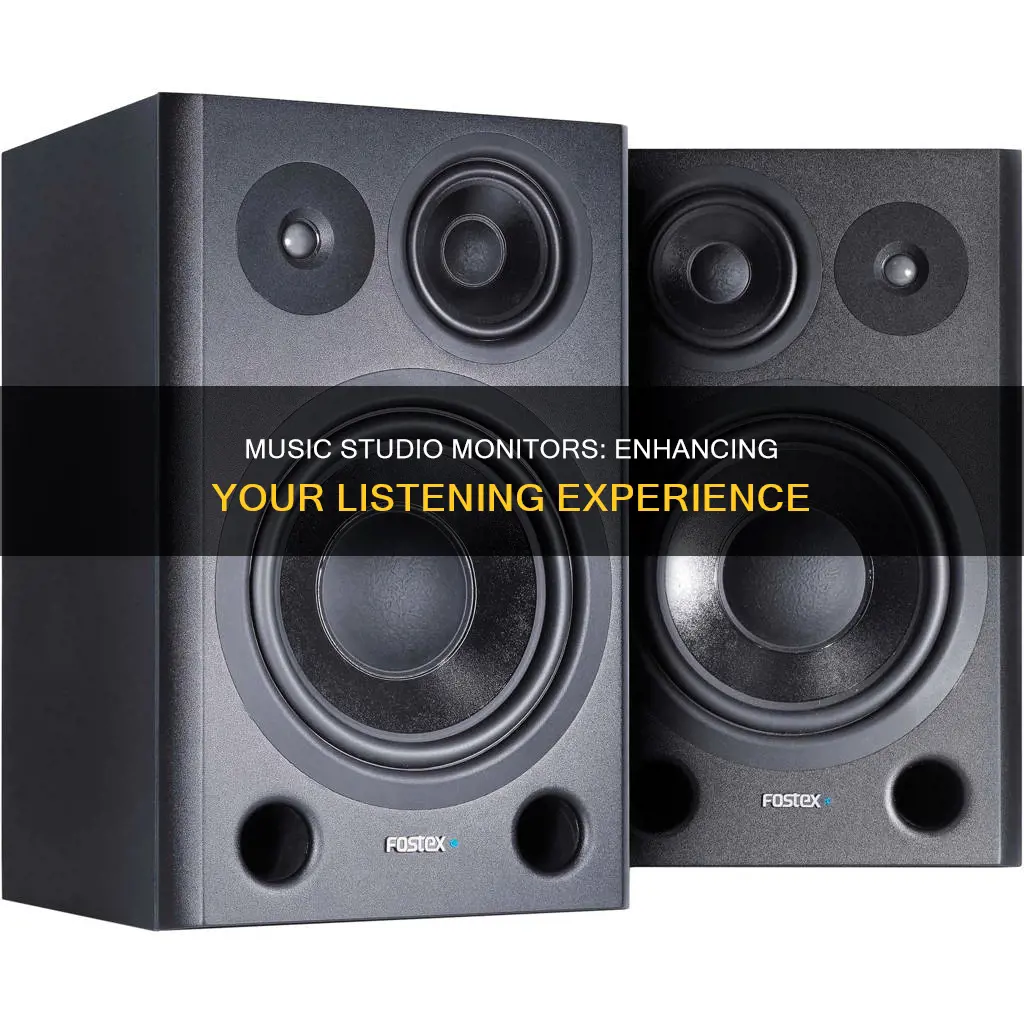
Studio monitors are designed to deliver sound with high fidelity, giving you an unaltered version of the original recording. They are often used in recording studios, radio stations and other professional audio environments to mix music, dialogue and sound effects. Studio monitors have a flat frequency response, meaning all frequencies are played at the same volume level. This is in contrast to regular Hi-Fi speakers, which are designed to emphasise certain frequencies, such as adding more bass to music. Studio monitors are ideal for professionals in music production, but may not suit all listeners due to their revealing nature.
| Characteristics | Values |
|---|---|
| Purpose | Studio monitors are designed for use in recording studios, radio stations, and other professional audio environments. |
| Use | Studio monitors are used to mix music, dialogue, and sound effects during the recording, mixing, and mastering processes. |
| Frequency Response | Studio monitors have a flat frequency response, meaning all frequencies are played at the same volume level. |
| Accuracy | Studio monitors aim to reproduce sound accurately and authentically, without adding any coloration. |
| Speaker Design | Most studio monitors have a two-way design with a woofer for low frequencies and a tweeter for high frequencies. High-end models may have a three-way design with a supplementary loudspeaker for medium frequencies. |
| Active vs. Passive | Studio monitors can be active (with built-in amplifiers) or passive (requiring external amplifiers). Active monitors are simpler to use, while passive monitors offer more flexibility. |
| Amplifier Configurations | Single-amp, bi-amp, and tri-amp configurations are available, offering varying levels of control over frequency response and sound reproduction. |
| Size | The size of studio monitors should align with the room size and music style. 5-inch woofers are commonly used in home studios. |
| Wattage | Wattage determines the monitor's ability to deliver sound levels without distortion. Higher wattage is generally needed for larger rooms or louder volumes. |
| Cost | The cost of studio monitors can vary depending on the user's level, from beginner to professional. Prices can range from around $200 to upwards of $1,000 per monitor. |
What You'll Learn

Studio monitors vs Hi-Fi speakers
Studio monitors and Hi-Fi speakers are designed for different purposes and listening environments. Studio monitors are engineered for accuracy and used in recording studios, radio stations, and other professional audio environments. On the other hand, Hi-Fi speakers are designed for home and car audio systems, as well as entertainment venues like clubs and bars.
Technical Differences:
Studio monitors have a flat frequency response, meaning all frequencies are played at the same volume level. This allows for accurate balancing of levels during mixing. In contrast, Hi-Fi speakers emphasise certain frequencies, such as adding more bass or boosting treble, to create an enhanced listening experience.
Studio monitors are typically active speakers, with built-in amplifiers, while Hi-Fi speakers are usually passive, requiring external amplifiers. Active monitors offer simplicity and dedicated amp channels for each driver, providing better control over frequency response.
Studio monitors are designed for near-field listening, meaning they are placed close to the listener for a precise, upfront sound. Hi-Fi speakers, on the other hand, are designed for far-field listening and can project sound in a broader direction, making their positioning in the room less critical.
Intended Use:
Studio monitors are used by audio professionals for critical listening, mixing, and mastering. They aim to deliver an unaltered version of the original recording, exposing every nuance and imperfection. Studio monitors are brutally honest and may not suit everyone's taste for everyday listening.
Hi-Fi speakers, on the other hand, are designed for enjoyable listening and are often tailored to sound appealing to the average listener. They may enhance certain frequencies to make the music more engaging.
The choice between studio monitors and Hi-Fi speakers depends on your specific needs and listening habits. If you prioritise accuracy and work in audio production, studio monitors are ideal. If you're a casual listener seeking an immersive and tailored experience, Hi-Fi speakers might be a better fit.
The Ultimate Size and Fit Guide for Ankle Monitors
You may want to see also

Active vs passive studio monitors
When it comes to studio monitors, the active vs passive debate is an important one to consider. Studio monitors are designed to offer a flat frequency response, meaning all frequencies are played at the same volume level, which is crucial for accurate mixing and mastering. The choice between active and passive monitors depends on your specific needs, budget, and production environment. So, what's the difference?
Active Studio Monitors
Active studio monitors have built-in amplifiers, which means they are simpler to set up and don't require any additional equipment. They are often more expensive upfront due to the built-in amplifiers, but they save space and reduce cable clutter. Active monitors are ideal for those who want a straightforward, plug-and-play setup and don't mind a higher upfront cost. They are commonly used in home studios, small project studios, and professional studios where space is limited.
Passive Studio Monitors
Passive studio monitors, on the other hand, require external amplifiers to function. They offer more flexibility as users can choose and upgrade amplifiers independently, allowing for more customization. Passive monitors are usually less expensive upfront but may require more space and can be more complex to set up, especially for beginners. They are often found in larger professional studios where customization and high-power amplification are required.
The decision between active and passive studio monitors depends on your specific needs and preferences. If you value convenience and simplicity, active monitors might be the better choice. On the other hand, if you enjoy customizing and upgrading your audio components, passive monitors may be more suitable. Additionally, your budget and available space will also play a role in your decision.
Cleaning Your LCD Monitor: Alcohol as a Safe Option
You may want to see also

Amplifier configurations
The single-amp configuration is the simplest option for active studio monitors. In this setup, the left and right speakers are powered by a single amplifier, which is integrated into one of the speakers. While this configuration is common for computer speakers, it is rarely used for studio monitors.
The bi-amp configuration offers greater control over the frequency response and more precise sound reproduction. In a bi-amp setup, each speaker has two amplifier modules. In a 2-way design, each driver has its own dedicated amplifier, allowing for a more accurate and detailed sound. Bi-amp configurations are often used in professional studios, where accuracy and precision are crucial.
The tri-amp configuration is the most advanced and complex option. In this setup, each driver in a 3-way speaker (woofer, midrange, and tweeter) has its own dedicated amplifier for low, mid, and high frequencies. This provides ultimate control over the frequency response and allows for the most precise sound reproduction. Tri-amp configurations are typically found in high-end professional studios, where the highest level of accuracy is required.
The choice between these amplifier configurations depends on the specific needs and requirements of the user. For example, a beginner may prefer the simplicity of a single-amp configuration, while a professional studio may require the precision and control offered by a tri-amp configuration. It's important to consider factors such as budget, space, and the level of accuracy needed when deciding on the amplifier configuration for a studio monitor setup.
Blind Spot Collision Monitoring: Kia Telluride EX's Safety Feature
You may want to see also

Studio monitor size
For home studios, 5-inch studio monitors are generally a good fit. This size is suitable for most music styles and room sizes, providing a balance between sound quality and space constraints. However, if you work with music that has a significant low-end frequency presence, such as EDM, larger studio monitors, like 8-inch options, may be preferable. Bigger woofers can move more air, enabling the reproduction of lower-frequency sounds.
It's worth noting that the size of the studio monitor should align with your room size. If you have a small room, larger monitors can easily activate room modes, causing issues like reflections, sound build-up, and frequency shifts. In such cases, sticking to studio monitors below 5 inches is recommended. Conversely, if you have a large room (at least 20 feet in length), larger monitors can be a good choice.
Additionally, the listening distance also plays a role in studio monitor size selection. Bigger studio monitors can be placed farther away from the listener and tend to have a wider sweet spot range. They are also louder, making them suitable for setups with larger mixing consoles or studio desks.
When choosing the right studio monitor size, it's important to strike a balance between the monitor size, room size, and your specific audio needs.
Monitoring Supplier Delivery Performance: Strategies for Success
You may want to see also

Studio monitor wattage
Studio monitors are designed for use in recording studios, radio stations, and other professional audio environments. They are used to mix music, dialogue, and sound effects during the recording, mixing, and mastering processes.
Wattage is an important factor when considering studio monitors as it determines the monitor's ability to deliver adequate sound levels without distortion. The amount of wattage required will depend on the size of the room and the desired sound levels. For beginners, or those working in small-to-medium-sized rooms, a studio monitor with 50-75 watts per channel is a good starting point. If you're working in a larger commercial studio, you may require something with more wattage, such as 100 watts or more per channel.
It's important to note that wattage alone does not determine the quality of a studio monitor. A well-designed, high-quality monitor with lower wattage can often outperform a cheaper monitor with higher wattage. The best way to determine the appropriate wattage for your needs is to test the monitors in your room and listen to your material without any distortion.
When choosing studio monitors, other factors to consider include the size of the monitor, the amplifier configuration, and your budget.
Adjusting Monitor Settings to Remove Black Edges
You may want to see also
Frequently asked questions
Studio monitors are designed to deliver sound with high fidelity, giving you a clear, unaltered version of the original recording. Regular speakers, on the other hand, are designed for an enjoyable listening experience and might enhance certain frequencies to make the music more appealing.
Studio monitors offer a level of authenticity that audiophiles and sound professionals often prefer. They provide a true-to-source sound, allowing you to experience songs as they were intended by the artist and producer. Studio monitors are also ideal for critical listening and music production tasks such as mixing and mastering.
Studio monitors may not suit all listeners due to their revealing nature. They expose every nuance in a track, including imperfections. They are designed for accuracy and precision rather than an enhanced listening experience. Additionally, studio monitors can be more expensive than regular speakers, and their directional sound means they work best when the listener is positioned directly in front of them.







